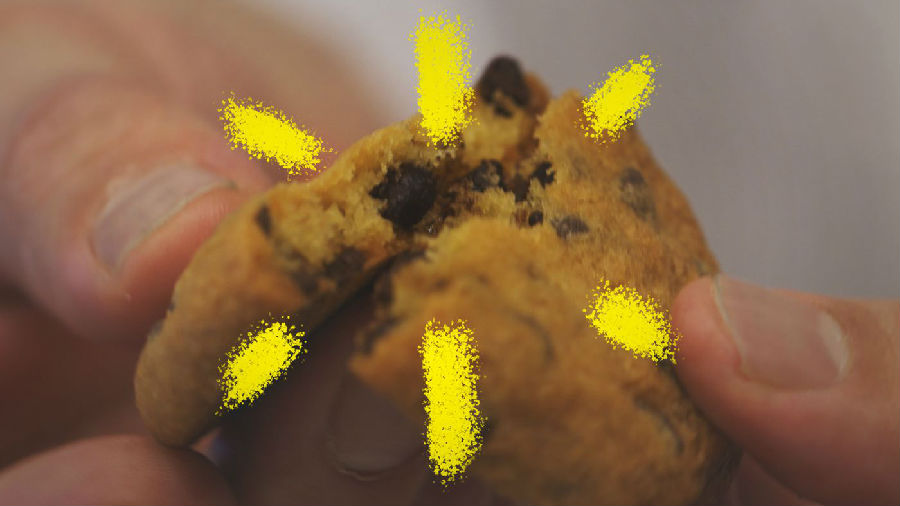You ever notice this instruction that’s in nearly every baking recipe?
大家有没有注意过几乎每一个烘焙食谱上都有一条这样的操作提示?
Preheating your oven to 350 degrees is sort of a basic requirement for baking in America.
在美国,将烤箱预热至350华氏度是烘焙的基本要求。
Our ovens even do it automatically as we turn them on,
我们的烤箱甚至会在我们打开烤箱时自动完成这一操作,
but have you ever stopped and asked yourself what’s so special about this number?
那你们是否有停下来问过自己,这个数字有什么特别之处没有?
I love to bake, but I’m certainly not a pastry chef, so let’s meet someone with a bit more experience.
我喜欢烘焙,但我绝对不是当糕点师的料,所以,我们还是来认识一个有更多经验的人吧。
This is Michael Laiskonis, the creative director at the Institute of Culinary Education.
这位是美国烹饪教育学院创意总监Michael Laiskonis。
He's a pastry chef.
他就是糕点师。
So temperature is really important in baking not only to develop color and flavor, but also to control the moisture in our products.
温度在烘烤过程中是非常重要,不仅对于控制食品的颜色和风味很重要,对控制食品中的水分也很重要。
As the temperature rises and moisture is lost at the surface,
随着温度升高,面团表面的水分蒸发,
we get browning and also the creation of flavor compounds that didn't exist in that product previously.
我们的面点会变成棕色,而且还会烘烤出之前的面团所没有的各种味道。
This happens because of a chemical process known as the maillard reaction,
这个过程发生了所谓的美拉德反应,
which occurs when proteins and sugars are transformed by heat and moisture.
也就是蛋白质和糖发生热量和含水量上的变化的过程。
When sugar molecules are exposed to the heat in your oven,
糖分子暴露在烤箱的高温下时,
they start to reduce – or break down – and interact with the proteins.
就会开始缩水 - 或分解 - 并与蛋白质发生反应。
That’s when you can see your pastry turning golden brown.
这个过程就是糕点变成金黄色的过程。
But it’s not just about that physical transformation.
但这不仅仅是一个物理变化的过程。
You can taste the effects of the maillard reaction too –
大家也可以品尝到美拉德反应的效果 -
that's what gives us the flavors of the golden crust on a piece of bread
就是这个反应让我们的面包金色的外壳有了那种脆脆的口感,
or a nice sear on a steak or that mellow richness of, say, caramelized onions.
让我们的牛排烤出了那种焦焦的颜色,让我们的洋葱有了那种醇厚丰富的口感。
The trick behind that reaction is to find the perfect temperature that sets it into action without over or under-doing it.
这个反应背后的诀窍就是找到一个完美的,能让这个反应顺利进行,同时即不会反应不足,也不会反应过度的温度。
These recipes might make you think that Maillard reaction occurs at 350 degrees, but actually ...
这些食谱可能会让你以为美拉德反应的反应温度是350度,但实际上......

So these Maillard reactions tend to occur at a fairly low temperature – around 230 to 240 degrees Fahrenheit.
这些美拉德反应的反应温度往往较低- 大约230到240华氏度。
You want to manipulate the rate at which this reaction occurs both at the surface and internally to get the results you want.
大家需要控制这个反应,让面点从内到外都发生美拉德反应,从而烤出我们想要的糕点。
If we bake too cool, the entire cookie, for example, will dry out before we get that surface drying that will lead to browning.
如果温度太低,比如烤饼干的话,整个饼干就会在还没有上色就变干。
If we bake things in too hot an oven, the opposite occurs and we get burning.
如果烤箱温度太高,相反的情况就是我们会把糕点烤焦。
To get it just right, we preheat the oven to 350 degrees so the Maillard reaction has time to occur throughout the entire cookie.
为了让这个反应发生得恰到好处,我们将烤箱预热到350度,这样,曲奇从内到外都能发生这个反应了。
For most home cooks and to also account for the fact that everyone's oven is slightly different,
对于大多数家庭厨师而言,并且,考虑到每个人的烤箱可能都稍有不同,
I think 350 is a great benchmark to work from.
我觉得350华氏度这个数值是一个很好的基准。
It’s a safe standard for most people, but the number can also be altered to yield slightly different results.
对大多数人来说,这是一个比较保险的标准,但是我们也可以通过改变这个温度来烤出不一样的糕点。
Some pastry chefs might bake at 325 if they want a lighter colored cookie, and some push it to 375 for a crispier outside.
有些糕点厨师可能会选用325度烘烤,如果他们想烤出颜色更浅一点的饼干的话,有些糕点厨师可能会调高到375度,这样烤出来的糕点表皮会更脆。
A lot of things that contemporary bakers tend to forget is not too long ago, in history,
当代面包师往往会忘记,就在不久以前,
we didn't have as much control over our ovens or being a pastry chef meant being able to build a fire and maintain an oven temperature.
我们对烤箱的温度其实没有很大把握,那个时候当糕点师意味着要自己生火,自己把握烤箱的温度
Before the 1900’s, when ovens didn’t have temperature regulators,
20世纪之前烤箱还没有温度调节器的时候,
recipe writers instructed bakers to “cook in a moderate” “hot” or “slow” oven depending on the food.
食谱作者会提示面包师根据食物“中火”“高温”或“文火”烘焙。
After the second world war, the temperature gauge was developed and it became widely popular across households.
二战后有了温度计并开始在家家户户中流行开来。
Modern ovens typically ranged from 200 to 550 degrees,
现代烤箱的温度范围通常是200华氏度到550华氏度,
so over time, recipe writers converted these temperature guidelines to actual numbers --
所以,随着时间的推移,食谱编写者将这些温度准则转换成了实际的数值 -
they settled on the 350 mark for “moderate” which was the sweet spot for baking.
他们将350华氏度作为“适度”的标准,也就是烘焙的最佳温度。
Using these more specific numbers is really a result of better oven design and better oven control.
使用这些具体的数字实际上是更好的烤箱设计和更好的烤箱控制的结果。
And the more you understand about what goes on inside your oven, the better results you'll get.
而且,你越了解烤箱内的情况,烤出来的糕点也就越理想。
And who doesn't want a better cookie?
而且谁不想烤出好吃的曲奇呢?


